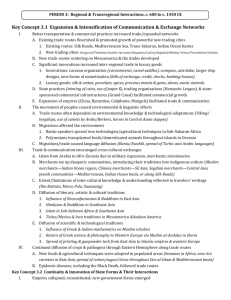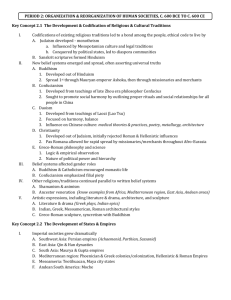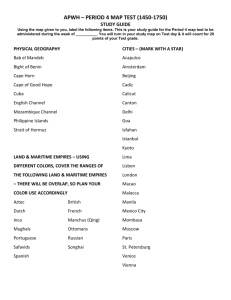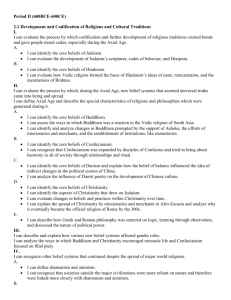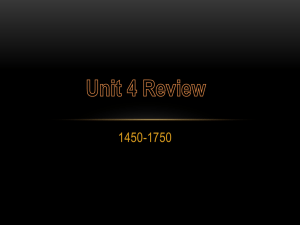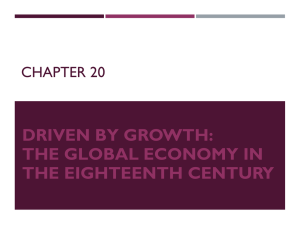APWH Presentations: Midterm exam Review Period 1
advertisement
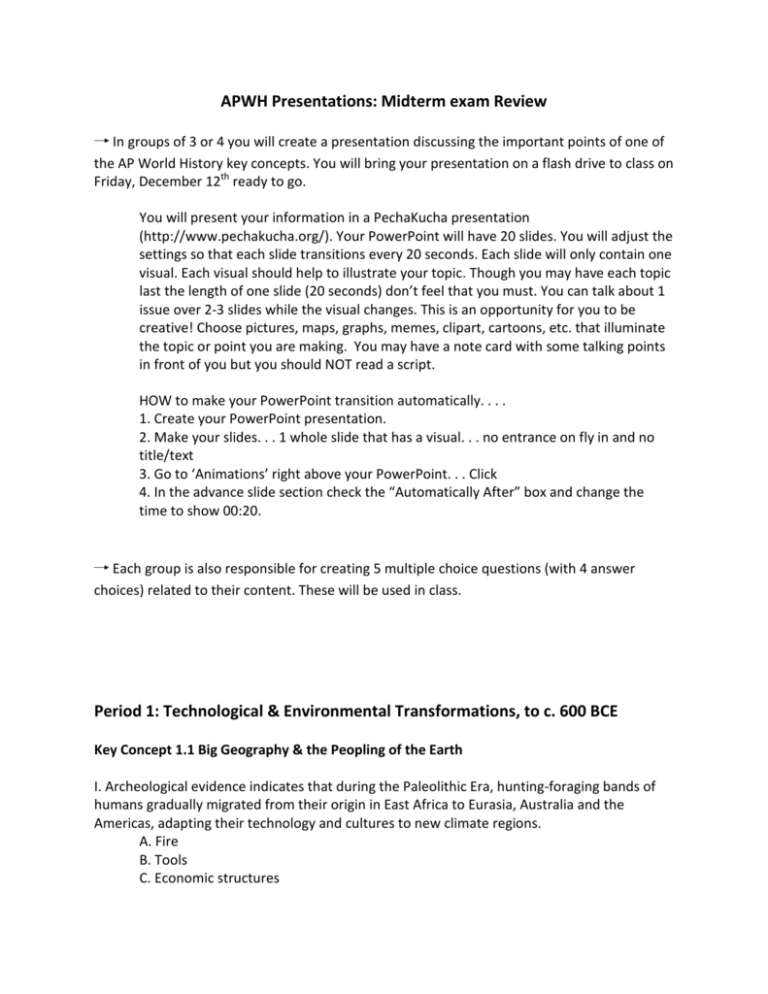
APWH Presentations: Midterm exam Review → In groups of 3 or 4 you will create a presentation discussing the important points of one of the AP World History key concepts. You will bring your presentation on a flash drive to class on Friday, December 12th ready to go. You will present your information in a PechaKucha presentation (http://www.pechakucha.org/). Your PowerPoint will have 20 slides. You will adjust the settings so that each slide transitions every 20 seconds. Each slide will only contain one visual. Each visual should help to illustrate your topic. Though you may have each topic last the length of one slide (20 seconds) don’t feel that you must. You can talk about 1 issue over 2-3 slides while the visual changes. This is an opportunity for you to be creative! Choose pictures, maps, graphs, memes, clipart, cartoons, etc. that illuminate the topic or point you are making. You may have a note card with some talking points in front of you but you should NOT read a script. HOW to make your PowerPoint transition automatically. . . . 1. Create your PowerPoint presentation. 2. Make your slides. . . 1 whole slide that has a visual. . . no entrance on fly in and no title/text 3. Go to ‘Animations’ right above your PowerPoint. . . Click 4. In the advance slide section check the “Automatically After” box and change the time to show 00:20. → Each group is also responsible for creating 5 multiple choice questions (with 4 answer choices) related to their content. These will be used in class. Period 1: Technological & Environmental Transformations, to c. 600 BCE Key Concept 1.1 Big Geography & the Peopling of the Earth I. Archeological evidence indicates that during the Paleolithic Era, hunting-foraging bands of humans gradually migrated from their origin in East Africa to Eurasia, Australia and the Americas, adapting their technology and cultures to new climate regions. A. Fire B. Tools C. Economic structures Key Concept 1.2 The Neolithic Revolution & Early Agricultural Societies I. Beginning about 10,000 years ago, the Neolithic Revolution led to the development of new and more complex economic and social systems. A. Agriculture emerged 1. Mesopotamia 2. Nile & sub-Saharan Africa 3. Indus River valley 4. Yellow River or Huang He valley 5. Papua-New Guinea 6. Mesoamerica & the Andes. B. Pastoralism developed C. Domestication of crops & animals D. Agricultural communities had to work cooperatively. E. Environmental Impact of Agriculture & Pastoralism II. Agriculture and pastoralism began to transform human societies. A. More reliable & abundant food supplies, increased population. B. Surpluses led to specialization of labor & new social classes. C. Technological innovations improved agricultural production, trade, transportation, pottery, plows, woven textiles, metallurgy, wheels & wheeled vehicles. D. Elites accumulated wealth, creating more hierarchical social structures & promoting patriarchy. Key Concept 1.3 The Development & Interactions of Early Agricultural, Pastoral, & Urban Societies I.Core and foundational civilizations developed in a variety of geographical and environmental settings where agriculture flourished. A. Mesopotamia in the Tigris & Euphrates River valleys B. Egypt in the Nile River valley C. Mohenjo-Daro & Harappa in the Indus River valley D. The Shang in the Yellow River or Huang He valley E. The Olmecs in Mesoamerica F. Chavín in Andean South America. II.The first states emerged within core civilizations. Buddhism and Christianity encouraged monastic life and Confucianism emphasized filial piety. A. Definition & characteristics of “States” 1. rulers had divine support 2. supported by military B. States grew & competed. Hittites’ developed iron. Those w/ more resources grew & conquered surrounding states C. Examples: Mesopotamia, Babylonia, Egypt, Nubia D. Pastoralists often developed & spread new weapons & modes of transportation, which transformed warfare. III. Culture played a significant role in unifying states through law, language, literature, religion, myths and monumental art. A. Monumental architecture & urban planning B. Elites promoted arts & artisanship C. Systems of recordkeeping D. Legal Codes E. New religious beliefs F. Trade expanded from local to regional & trans-regional G. Social & gender hierarchies intensified H. Literature, which also reflected culture Period 2: Organization & Reorganization of Human Societies, c. 600 BCE to c. 600 CE Key Concept 2.1 The Development & Codification of Religious & Cultural Traditions I. Codifications and further developments of existing religious traditions provided a bond among the people and an ethical code to live by. A. Judaism developed 1. Influenced by Mesopotamian culture & legal traditions 2. Conquered by political states which led to diaspora communities B. Sanskrit scriptures formed Hinduism(s) II. New belief systems and cultural traditions emerged and spread, often asserting universal truths. A. Buddhism B. Confucianism C. Daoism D. Christianity E. Greco-Roman philosophy & science III.Belief systems affected gender roles. IV. Other religious and cultural traditions continued parallel to the codified, written belief systems in core civilizations. A. Shamanism & animism B. Ancestor veneration V. Artistic expressions, including literature and drama, architecture, and sculpture, show distinctive cultural developments. A. Literature & drama B. Indian, Greek, Mesoamerican, & Roman architectural styles. C. Greco-Roman sculpture, syncretism w/ Buddhism Key Concept 2.2 The Development of States & Empires I. The number and size of imperial societies grew dramatically by imposing political unity on areas where there had previously been competing states. A. Persian Empires B. Qin & Han dynasties C. Maurya & Gupta Empires D. Phoenician & Greek colonies/colonization, Hellenistic & Roman Empires E. Teotihuacan, Maya city states F. Moche II. Empires and states developed new techniques of imperial administration based, in part, on the success of earlier political forms. A. Rulers created centralized governments, elaborate legal systems, & bureaucracies. B. Imperial governments projected military power C. Much of the success of empires rested on their promotion of trade & economic integration III. Unique social and economic dimensions developed in imperial societies in Afro-Eurasia and the Americas. A. Function of Cities 1. centers of trade 2. religious rituals 3. political administration B. Social hierarchies 1) cultivators; 2) laborers; 3) slaves; 4) artisans; 5) merchants; 6) elites; 7) caste groups. C. Methods used to produce food, rewards for elites. D. Patriarchy continued to shape gender & family relations. IV. The Roman, Han, Persian, Mauryan, and Gupta empires created political, cultural, and administrative difficulties that they could not manage, which eventually led to their decline, collapse and transformation into successor empires or states. A. Empires caused environmental damage & generated social tensions & economic difficulties. B. External problems resulted from the threat of invasions Key Concept 2.3 Emergence of Transregional Networks of Communication & Exchange I.Land and water routes became the basis for transregional trade, communication and exchange networks in the Eastern Hemisphere, while somewhat later separate networks connected the peoples and societies of the Americas. A. Eurasian Silk Roads B. Trans-Saharan caravan routes C. Indian Ocean sea lanes D. Mediterranean sea lanes II.New technologies facilitated long-distance communication and exchange. A. New technologies led to domesticated pack animals, promoted longer routes. B. Maritime technologies, monsoon winds III. Alongside the trade in goods, exchanges of people, technology, religious and cultural beliefs,food crops, domesticated animals and disease pathogens developed across far-flung networks of communication and exchange. A. crops promoted changes in farming & irrigation B. Diseases decrease urban populations, also contribute to decline of empires (Rome & Han) C. Religious & cultural Period 3: Regional & Transregional Interactions, c. 600 to c. 1450 CE Key Concept 3.1 Expansion & Intensification of Communication & Exchange Networks I. Improved transportation technologies and commercial practices led to an increased volume of trade, and expanded the geographical range of existing and newly-active trade networks. A. Existing routes flourished, increased growth of powerful new trading cities. B. New trade routes developed between Mesoamerica & the Andes C. significant innovations increase inter-regional trade in luxury goods D. State practices, trading organizations, & state-sponsored commercial infrastructures commercial growth E. The expansion of existing & new empires facilitated trans-Eurasian trade & communication. 1. new peoples were drawn into their conquerors’ economies & trade networks. II. The movement of peoples caused environmental and linguistic effects. A. Trade routes often depended on peoples’ understanding & technological adaptations. B. Migrations affect environment 1. Bantus, iron technology in sub-Saharan Africa 2. Polynesians, foods & animals in Oceania C. Migrations & trade led to diffusion/creation of languages III. Cross-cultural exchanges were fostered by the intensification of existing or the creation of new networks of trade and communication. A. Islam from Arabia expands into Afro-Eurasia due to military, merchants & missionaries. B. Merchants introduced their culture into indigenous areas. C. Extent/limitations of inter-cultural knowledge & understanding reflected in travelers’ writings D. Diffusion of literary, artistic, & cultural traditions E. Diffusion of scientific & technological traditions IV. There was continued diffusion of crops and pathogens throughout the Eastern Hemisphere along the trade routes. A. New foods (cotton, sugar, citrus) & agric tech affected urban areas (Dar al-Islam & Mediterranean) B. Epidemic diseases followed trade routes Key Concept 3.2 Continuity & Innovation of State Forms & Their Interactions I. Empires collapsed and were reconstituted; in some regions new state forms emerged. A. After empires collapsed, most states kept the best and adapted the rest. (Byzantine Empire, Sui, Tang, & Song) B. New forms of governance emerged 1. Caliphate 2. Mongol khanates 3. City-states (Italy, E Africa, SE Asia) C. States synthesized traditions D. In Americas state systems expanded, networks of city-states flourished, Aztecs & Inca began. II. Inter-regional contacts and conflicts between states and empires encouraged significant technological and cultural transfers, for example between Tang China and the Abbasids, across the Mongol empires and during the Crusades. Key Concept 3.3 Increased Economic Productive Capacity & Its Consequences I. Innovations stimulated agricultural and industrial production in many regions. A. Technological innovations increase agricultural production B. Demand for luxury goods affects crops transported C. China, Persia, & India increase productions of textiles & porcelains; China increases production of iron & steel II. The fate of cities varied greatly, with periods of significant decline, and periods of increased urbanization buoyed by rising productivity and expanding trade networks. A. Declines caused by: 1. invasions 2. disease 3. agricultural productivity 4. Little Ice Age. B. Revival caused by: 1. End of invasions 2. Safe & reliable transport 3. Rise of commerce 4. Warmer temperatures 5. Agricultural productivity increases population & increases labor leading to urban growth. C. Role of cities NOTE: Students should be able to explain functions of at least two major cities. 1. continued to play roles as governmental, religious, commercial centers 2. older cities declined 3. new cities took on these roles III. Despite significant continuities in social structures and in methods of production, there were also some important changes in labor management and in the effects of religious conversion on gender relations and family life. A. Continued Labor systems included 1. free peasants 2. nomadic pastoralism 3. craft production & guild organization 4. coerced/unfree labor 5. government imposed labor taxes/military obligations. B. Social structures shaped by class & caste hierarchies. Patriarchy persisted, but women exercised more power & influence in Mongols, W. Africa, Japan, SE Asia C. New forms of coerced labor appeared 1. serfdom in Europe & Japan 2. elaboration of the mit’a in the Inca Empire. 3. Free peasants resisted attempts to raise dues & taxes by staging revolts 4. The demand for slaves for both military & domestic purposes increased D. Diffusion of Buddhism, Christianity, Islam & Neo-Confucianism affect gender relations & family structure. Period 4: Global Interactions, c. 1450 to c. 1750 Key Concept 4.1 Globalizing Networks of Communication & Exchange I. In the context of the new global circulation of goods, there was an intensification of all existing regional trade networks that brought prosperity and economic disruption to the merchants and governments in the trading regions of the Indian Ocean, Mediterranean, Sahara, and overland Eurasia. II. European technological developments in cartography and navigation built on previous knowledge developed in the classical, Islamic and Asian worlds, and included the production of new tools (such as astrolabe or revised maps), innovations in ship designs (such as caravels) and an improved understanding of global wind and currents patterns, all of which made transoceanic travel and trade possible. III. Remarkable new transoceanic maritime reconnaissance occurred in this period. A. Chinese: Zheng He in Indian Ocean B. Portuguese in West Africa, global trading-post empire. C. Spanish: Columbus, increased European interest in travel & trade. D. N Atlantic: crossings continued & spurred European searches for routes to Asia. IV. The new global circulation of goods was facilitated by royal chartered European monopoly companies who took silver from Spanish colonies in the Americas to purchase Asian goods for the Atlantic markets, but regional markets continued to flourish in Afro-Eurasia using established commercial practices and new transoceanic shipping services developed by European merchants. A. Europeans in Asia mostly transported goods within Asia/Indian Ocean B. Silver from Americas leads to Commercialization/global economy C. Europeans used joint-stock co’s (mercantilism) D. The Atlantic system: goods, wealth, free & unfree laborers V. The new connections between the Eastern and Western hemispheres resulted in the Columbian Exchange. A. European colonization of the Americas lead to diseases & vermin B. American foods affect Europe, Asia, & Africa. Plantations’ cash crops affect Europe & Middle East C. Deliberate transfer of grains & animals D. Afro-Eurasians benefitted nutritionally from American foods E. European Colonization, agriculture & settlements affected the environment VI. The increase in interactions between newly connected hemispheres and intensification of connections within hemispheres expanded the spread and reform of existing religions and created syncretic belief systems and practices. A. Islam develop Sunni, Shi’a, & Sufi traditions & continued to spread into Asia & Africa, adapting to local cultures as it spread B. Christianity spread throughout the world. Diffusion & Protestant Reformation lead to diversification C. Buddhism spread w/in Asia. D. Syncretic religions developed (vodun, Sikhism) VII. As merchants’ profits increased and governments collected more taxes, funding for the visual and performing arts, even for popular audiences, increased. A. Artistic Innovations all over the world B. Literacy expanded along w/ popular literary authors & forms in Africa, Europe, & Asia
